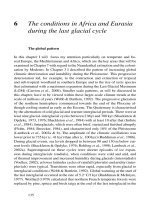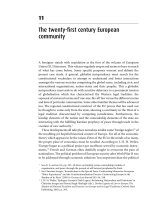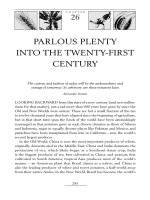LAST HUNTERS, FIRST FARMERS
Bạn đang xem bản rút gọn của tài liệu. Xem và tải ngay bản đầy đủ của tài liệu tại đây (537.34 KB, 18 trang )
7
CHAPTER
1
LAST HUNTERS,
FIRST FARMERS
Animals feed, man eats; the man of intellect alone knows how to eat.
Anthelme Brilllat Savarin (1755–1826)
Acorns were good until bread was found.
Francis Bacon (1561–1626)
OUR ANCESTORS began the deliberate and systematic hunting of ani-
mals some 700,000 years ago in Africa. Before this their diet had been
based mostly on plant foods, occasionally enlivened with meat from scav-
enged carcasses – other animals’ leftovers. But by the time we became
Homo sapiens – Our Kind – which happened in eastern Africa some 100,000
years ago, we were hunters, not scavengers – opportunistic hunters who
apparently became so good at it that those ancestors put a considerable dent
in their food supply. Around 80,000 years ago they began to radiate out of
northeast Africa to western Asia, where they once again encountered plenty
of protein on the hoof, and in this larger world they mustered the momen-
tum to out-compete all others of the genus Homo that had preceded them.
This was the modern human species, which began colonizing Australia
around 50,000 years ago, moved from the Asian steppes into Europe from
around 40,000 years ago, and into the Americas 15,000 to 30,000 years
ago. And it was in these wanderings that the progressively larger brains of
humans gave birth to progressively better tools and weapons and increas-
ing social organization.
8
A Movable Feast
There is evidence of specialized hunting strategies by 20,000 years
ago that allowed our big-brained ancestors to consistently bag really big
game. In the middle latitudes of Eurasia large gregarious herbivores such as
horses, wooly mammoths, reindeer, and bison were victims of these strate-
gies. Elsewhere the prey consisted of buffalo, wild pig, aurochs, and camel.
Large animal carcasses had numerous advantages over plant foods. A day
of foraging for plants produced the food value of just one small animal,
whereas by eating animals humans took in a highly concentrated food that
contained all the essential amino acids. Moreover one large animal could
feed an entire band, and food sharing seems to have been the norm for
hunter-gatherers.
1
Others of Our Kind made a living from the water. Ancient rock art
the world over depicts fi sh, although it is relatively silent about how they
were caught. Probably, until late in the Paleolithic – when bows, arrows,
and harpoons appeared, large animals were on their way to extinction,
and fl imsy dugout canoes and reed rafts were replaced by more reliable
watercraft – fi sh procurement was largely limited to rivers. There fi sh
could be taken with clubs, spears, nets made of twisted fi ber, and lines (the
fi sh-gorge, a kind of hook, dates from around 27,000 years ago) often after
damming the water. Then, too, hunter-gatherers were surely familiar with
the annual “runs” of various anadromous species such as salmon that swim
from the ocean into and up ancestral rivers to spawn.
2
The exploitation of coastal, as opposed to riverine environments, involved
not so much fi sh, but shellfi sh – mussels, oysters, cockles, scallops, whelks,
clams and the like – whose shells comprise the myriad middens of both
Paleolithic and Neolithic origin found on seacoasts and rivers around the
world. The succulent nuggets within these shells represented easily col-
lected, high-quality protein (and also bait for fi shing) – the drawback being
that the food came in small increments so that large-scale gathering efforts
were required. Sea slugs and sea anemones were also collected (still eaten
by the French), as were lampreys – too many are famously said to have
killed England’s Henry II in 1189. Inland, mollusks such as snails also
offered a living to gatherers – their discarded shells contributing to still
other middens.
Many coastal and inland middens indicate intensive activity during the
early years of the Neolithic – perhaps another indication of big game dis-
appearing? In any event, collecting mollusks must have been a pleasant
alternative to the rigors (and dangers) of the hunt or labor in the fi elds. So
Last Hunters, First Farmers
9
too was the collection of health-giving algae – excellent sources of vita-
mins, minerals, even fats.
3
Perhaps the only reason that beaches were not
jammed was that the coasts could not provide enough food for everyone.
Giant sea turtles were another vital marine resource for many, although
reliable watercraft were required to exploit their eggs, which were often
deposited on uninhabited offshore islands.
4
The eggs, of all of the six or
seven species (the number is in dispute) of these giant marine reptiles have
long been good food for humans but the sea turtle most favored for its
veal-like meat is the green turtle ( Chelonia mydas) – named green not for
its color but for the green gelatinous substance found underneath its lower
shell, called “calipee.” When scraped out, calipee is the base for the justly
famous green turtle soup.
5
Even though sea turtles are easy to catch when
out of the water, turtle fl esh – but not turtle eggs – is avoided by many
around the world. For others, however, like the coastal Miskito population
of Nicaragua, whose home coasts are one of the principal feeding grounds
for green turtles, they are a staple.
6
Many of these foods, including turtle eggs, were eaten raw throughout
much of humankind’s time on earth and some still are, like oysters, clams,
mussels, fi sh, and fi sh eggs (caviar and its pretenders). In Japan eating raw
fi sh (called sashimi since the seventeenth century) has been traditional
since ancient times.
7
Meats, too, are still eaten raw, such as hams (although
cured or smoked) and beef (as steak tartare and carpaccio).
Insects consumed, sometimes raw and sometimes cooked, served as
another important food source for hunter-gatherers and their descendents.
To name but a few of the many more than one thousand species that have
fi gured into the practice of entomophagy: North American natives ate the
larvae of moths, grasshoppers, crickets, and caterpillars; in Mexico several
hundred species of insects, including caterpillars, dragonfl ies, ants, bees,
and wasps, are still eaten; and in South America giant queen ants are not
only thought tasty but are depended on as an aphrodisiac as well.
8
In the Old World the ancient Greeks and Romans enjoyed grasshoppers
and large grubs, and European peasants continued to make insects impor-
tant sources of protein until the nineteenth century. In Africa entomophagy
is still practiced on a large scale with caterpillars (“the snack that crawls”) a
widespread favorite. Locusts, termites, and palm grubs are also commonly
eaten. Until recently locusts were regularly popped into human mouths in
South Asia and the Middle East. Beetle consumption has long been popu-
lar in Southeast Asia, where ant larvae and pupae are not only regularly
10
A Movable Feast
consumed but also canned and exported to spe-
cialty food outlets, as is bee brood. Silkworm
pupae are shipped to the United States from
Korea and regularly consumed in China. The
Japanese are fond of wasp pupae and larvae,
and locusts are regularly consumed through-
out East Asia. In Australia the black honey ant,
a special kind of bee, and witchetty and bardi
grubs (the larvae of a moth and a beetle, respec-
tively) were all local delicacies for hunter-gatherers
that have recently found their way into restaurant
menus – a modern reminder that these were all important Aborigine foods,
along with moths collected during migrations.
9
Vegetables and fruits comprise other groups of foods often eaten raw.
Lettuce has been fried and boiled, but as a rule it is not. One does not
say raw oranges to differentiate them from cooked varieties because they
are seldom cooked – a good thing, too, because heat kills the vitamin C
they contain. But, this having been said, although numerous food items
have been, and still are, eaten raw, cooked food is generally the best tast-
ing and the best for us. Heat destroys toxins in plants and unwanted
wildlife in meat and fi sh such as worms and a gamut of smaller patho-
gens.
10
It increases the nutritional value of many foods, makes others
more digestible by the denaturation of protein and the gelation of starch,
even makes some inedible foods edible. Cooking softens tough foods by
breaking down animal and vegetable fi bers while simultaneously liberat-
ing protein and carbohydrate materials – indeed, starch requires heat to
release its sugars.
11
The domestication of fi re, then, was not only the fi rst but the most
important of all the domestications that humankind has managed. Although
its permanent acquisition is told in a thousand myths and legends, gener-
ally of divine gift-giving, in reality fi re must have been acquired only to
be lost again countless times over millennia as (often painful) trial and
error led from the capture of naturally occurring fi re (fi re collecting) to
its preservation in embers that could later be fanned into fl ame. Tamed
fi re (fi re production) was probably initially employed for illumination, to
frighten away dangerous carnivores, and for hunting rather than for cooking.
However as cooking became routine, more reliable tools for fi re kindling
such as fl ints, fi re drills, and other friction devices came about, and the art
Last Hunters, First Farmers
11
of making charcoal was developed to fuel human progress from the Stone
Age to the Iron Age to the Backyard Barbecue Age.
Cooking almost certainly came about by accident, and one suspects
that there were an infi nitesimal number of accidents that called human
attention to the process, such as the fanciful account of Charles Lamb.
Appearing in an 1823 issue of London Magazine, the essay posited a litter
of piglets trapped in a burning dwelling in China. In the aftermath of the
fi re the swineherd noticed the appetizing odor of roasted pig, and tasted
the crisp fl esh. Soon pigs were being immolated in other buildings delib-
erately set on fi re until, fi nally, it dawned on the arsonists that the cooking
fuel need not be an edifi ce.
12
With apologies to Lamb, however, cooking
was underway and fi re had been domesticated long before the pig entered
this state.
Some credit Peking man, a hominid living around a half million years
ago with the fi rst use of fi re.
13
Others have placed the event in Africa
some million years earlier, but few dispute that fi re has been the property
of almost all humans for the last 100,000 years. It is true that earthen
hearths baked by repeated fi res were not numerous until around 40,000
years ago, but this does not mean that fi re was not used with regularity.
Rather it merely reminds us that hunter-gatherer bands regularly changed
their address, and there seems little doubt that at this point humans had
graduated from fi re collecting to fi re producing.
14
Presumably roasting foods directly over the fl ame was the fi rst method
used. But they were also steamed in bags made with skins and stomachs
suspended over the fi re. Charred fl at stones from ancient sites suggest that
grilling may have taken place, and hot pebbles and stones were placed in
wooden vessels for making porridges whereas holes dug in the ground served
as ovens for baking roots and tubers. Pit-cooking a variety of foods came
next, and the rudiments of cookery magic were established – a magic that
became even more powerful with the use of pottery vessels that began in
the Middle East around 8,000 years ago (earlier in Japan and China), which
simplifi ed boiling, even promoted frying.
15
Grains that had previously been
toasted could now be boiled, and this, coupled with their domestication – a
procedure that involved the selection and propagation of desirable traits
along with the elimination of those deemed undesirable – made them more
digestible. Interestingly, regularly cooking foods promoted a substantial
reduction in human tooth size. We simply no longer needed large teeth for
tearing at raw meat or chewing tough fi brous plants.
12
A Movable Feast
But fi re served humans in many ways besides cooking. With it they
could begin rearranging environments to suit themselves, clearing land to
stimulate the growth of wild foods and opening landscapes to encourage
the proliferation of food animals, that could be later driven by fi re to a
place chosen to harvest them. In addition, fi re stimulated the growth of
grasses – a kind of bait for herbivores.
16
Fire, as a weapon in the arsenal of early humans, was useful for driving
away unfriendly animals too dangerous to spear (especially in the dark),
but more importantly was applied to cornering game, even driving large
numbers off cliffs. Other weapons entered that arsenal over time such as the
atlatl and bow and arrow. These were more powerful than the spear – so
much so that they confused the instinctive fl ight distance of prey – the
range that an animal will permit a predator to approach before fl eeing.
Such technologies, in turn, promoted increasingly sophisticated hunting
strategies that took a quantum leap forward with the transformation of the
wolf into a hunting dog around 16000
BCE
. As Alfred Crosby points out,
humans were now substituting cultural evolution for genetic evolution
17
– a
substitution that in progressively removing humans from nature’s rhythm
was fraught with myriad consequences.
One of these consequences, not long in coming, was to thrust humankind
onto the horns of the Malthusian dilemma. Increased food production,
coupled with cooking, delivered more in the way of whole protein to the
young, which ensured that more individuals survived to adulthood. Yet as
humans grew more numerous, this meant more pressure on the large game
animals (megafauna) they fed on. These dwindled in numbers and in the
end became extinct as several genera and numerous species disappeared.
Human populations were expanding to the outer limits of a food supply
now diminishing in the face of the planet’s champion predator, and – to
spread the blame – in the face of climatic change as the Pleistocene epoch
came to an end.
One way out of the dilemma was for people to become more celibate,
but this was apparently not an option for Our Kind, who dug in to invent
agriculture instead. They could not have realized that they were trading in
a life of ease (contemporary hunter-gatherers work only about a dozen or
two hours weekly to get food together and to make, maintain, and repair
weapons and implements) for one of back-breaking labor from sunup to
sundown with a narrow-minded concentration on a single crop.
18
And they
had no way of knowing that they were exchanging good health for famine
Last Hunters, First Farmers
13
and nutritional diseases, not to mention swapping plenty of elbowroom
for crowded living conditions – conditions that helped open the door to
plague and pestilence.
But even had people been more prescient, would population pressure
and resource depletion have left them with any other choice? Or had lead-
ers recognized that settled agriculture would increase their control over
resources and consequently enhance their own personal power? Or was it
simply that people, previously confi ned to remote bands, began to enjoy
the excitement of living in seasonal settlements and converted them into
permanent villages? No matter what the precipitating factors, the people
who made the transition from foraging to farming only gradually discov-
ered the pitfalls because the transition was a leisurely one.
It had its beginnings around 17000
BCE
, several millennia before the
one million years of the climactic tumult of the Pleistocene shaded into
the Holocene. It was then that wild emmer and einkorn grains were fi rst
harvested in the Fertile Crescent of the Middle East, as were broad beans
in southwestern Asia, and a couple of kinds of broad beans may have even
been domesticated in northeast Thailand. Eleven thousand years ago is the
date generally assigned to the start of the Holocene, which saw the begin-
ning of agriculture and is the age we live in today.
Such early agricultural experiments were stimulated by the changing
climate at the close of the last great Ice Age. It was a gradual, but cata-
clysmic, process that lasted for nearly 100 centuries and ended only at the
start of the Copper Age. Rising seas, caused by melting glaciers, exacer-
bated the population problem by inundating land bridges to those New
Worlds of the planet that had been safety valves for excessive numbers.
However, left behind in compensation for those not following the animals
retreating with the glaciers was a stable climate favorable to the spread of
wild cereal plants and, consequently, also favorable to the multiplication
of herbivorous animals. That stable climate has continued to persist for
the last 10,000 years during which the human diet that had leaned heavily
on animal protein tilted back towards plants – and this despite the domes-
tication of barnyard animals.









